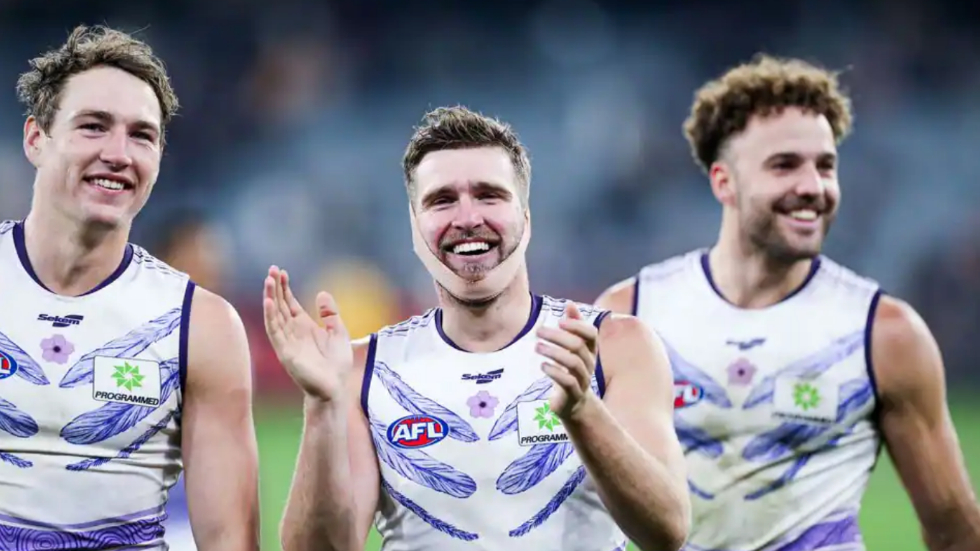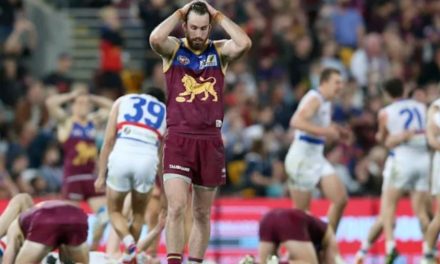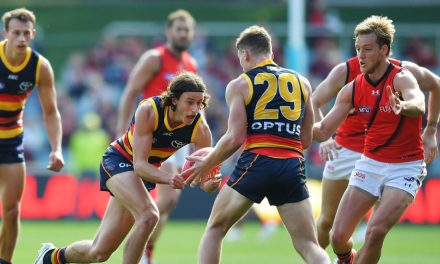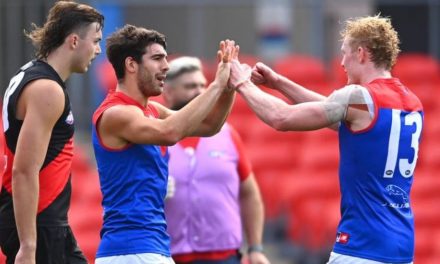Brennan Cox (left), Luke Ryan (middle) and Griffin Logue have all starred for Fremantle this year. Photo: AFL Media
Fremantle is set to play finals for the first time since 2015, bringing to an end their longest run without a top-eight appearance since the club first qualified in 2003.
In finishing fifth, Justin Longmuir’s side has risen six spots, playing a focused pressure game that makes it difficult to play against.
While their form this year has undergone a significant jump, the Dockers’ list build since Ross Lyon’s contending sides missed their shot has been methodical and calculated. Looking at their strike rate in the three key pillars of recruiting in that time, perhaps their rapid improvement this year is not so surprising at all.
Take their investment in their early rounds of the national draft as the first case.
Most clubs should, and do, call out the correct names at the top end of the draft these days. So, whilst getting your early selections right is always important, it doesn’t necessarily set you apart. What’s required is a concentration of high picks.
Seeing the writing on the wall at the end of 2017, Fremantle resisted the urge to on-trade the generous pick two it successfully lured from the Gold Coast for Lachie Weller, instead taking it to the draft along with its own selection.
With two picks inside the top five, the Dockers walked away with the AFLPA’s Most Valuable Player Andrew Brayshaw, as well as Adam Cerra.
They were not so savvy in 2018, jumping at the chance to finally recruit West Australian Jesse Hogan after a pick merry-go-round that resulted from Lachie Neale’s surprise trade request. But the following season they again invested in youth by taking Hayden Young, Caleb Serong and Liam Henry with consecutive picks inside the top 10.
Heath Chapman looks a fantastic selection at 14 in 2020, and last year they again loaded up at the front by taking Jye Amiss and Neil Erasmus at picks eight and 10 respectively, after Adam Cerra’s trade earned them nearly as much as what they spent on him four years earlier.
As a result, coming into 2022, Fremantle had plenty of untapped development in players who are now regarded as genuine top-liners.
Countless failed rebuilds have demonstrated that simply taking one selection at the top of the draft each year is not enough. This is one reason why North Melbourne’s progression out of the mire has been so slow, and as yet there hasn’t been a strong determination to correct this.
Conversely, successful rebuilds of sides like Hawthorn and Melbourne – one way or another – have shown the benefits of striving for high draft picks in clusters.
The second area in which Fremantle has excelled since 2016 is in regularly nailing its later picks. This is harder to do than people generally realise. Beyond about pick 20, the hit rate for retention beyond a player’s initial contract extension is poor.
Given that most very high picks work out to be solid best-22 players at the very least, when a club gets value from a significant number of later selections, it’s an instant edge on the competition.
PLEASE HELP US CONTINUE TO THRIVE BY BECOMING AN OFFICIAL FOOTYOLOGY PATRON. JUST CLICK THIS LINK.
The Dockers have this edge.
Between 2016, when the side crashed out of contention, and 2020, when Longmuir took over, they selected Brennan Cox, Luke Ryan, Michael Frederick, Lachie Schultz, Brandon Walker and Sam Switkowski with selections ranging between 43 and 71.
Bailey Banfield was an even bigger bargain at pick five in the 2018 rookie draft, while gun ruckman Sean Darcy was taken as a steal at 38 in 2016. When fit, all of these players have played key roles in delivering a highly tactical, highly effective game plan. They aren’t what one would term “list cloggers”.
Looking over premiership line-ups in the modern era, they are of course rich with high-level talent, much of it secured in the early part of the draft. But there is always an array of boom selections that help set the side apart. The Jeremy McGoverns and the Kane Lamberts, for instance. The Dockers have these players, and what’s more, they all seem to be getting better.
Crucially, and perhaps uncharacteristically given its history in this department, Fremantle has also reaped the benefits of shrewd pick-ups at the trade table.
It’s fair to say that the Dockers have not traditionally been a destination club, with unsuccessful attempts at luring the likes of James Frawley, Jack Riewoldt, Harry Taylor and Cale Hooker limiting the Lyon era. And yet, Fremantle’s best side this season has included no fewer than six recruits from other clubs, all clearly playing their best footy of their careers.
Rory Lobb, James Aish, Will Brodie, Blake Acres, Travis Colyer and Jordan Clark weren’t high-profile recruits commanding top selections or (with the likely exception of Lobb) tier-one contracts, but they have been able to extract the best out of themselves in a side that’s given them a clear and defined purpose.
For a few of these players, it’s taken years, and many observers will have given up on them entirely prior to this season. That they have all found their best footy in Cockburn is testament to the coaching and recruiting, but is also yet another advantage they have gleaned out of a highly competitive trade market.
That Fremantle is enjoying a critical mass of career-best seasons out of many of their lesser lights is significant, and not necessarily repeatable. But given the right list, it is a recipe for rapid improvement.
Outside of the absolute cream of the crop, last year Melbourne also got career years from the likes of Harrison Petty, Ed Langdon, Alex Neal-Bullen, Bayley Fritsch and James Harmes.
This season Fremantle has extracted the utmost out of Aish, Clark, Lobb, Frederick, Acres, Brodie, Cox, Schultz and also Griffin Logue, himself a former top-10 draft pick.
This may not get them to the flag this season, and the Dockers may not get the same critical mass again. But given their commitment to the pointy end of the draft, and success in the three key facets of recruiting, they’ve given themselves every chance at sustained success. And we shouldn’t be surprised again if it comes.











